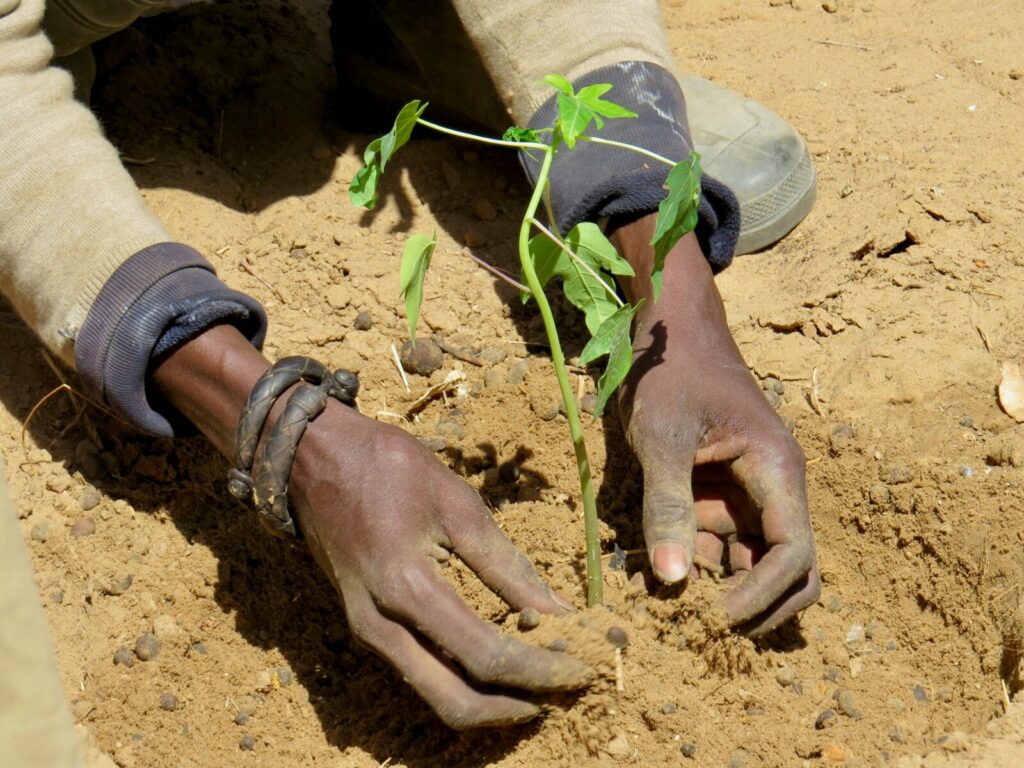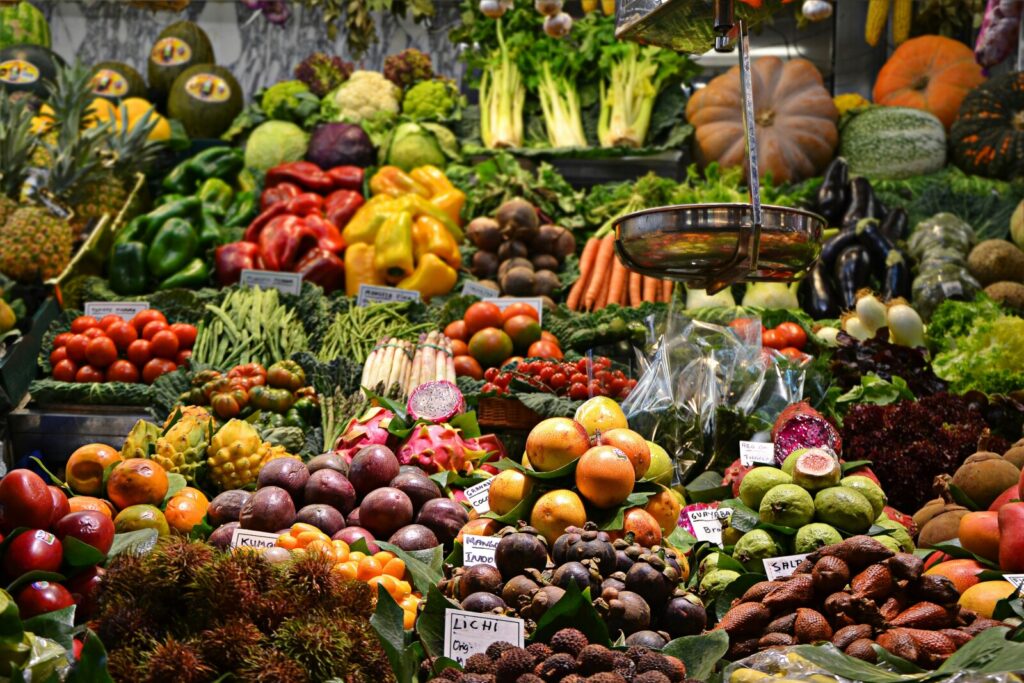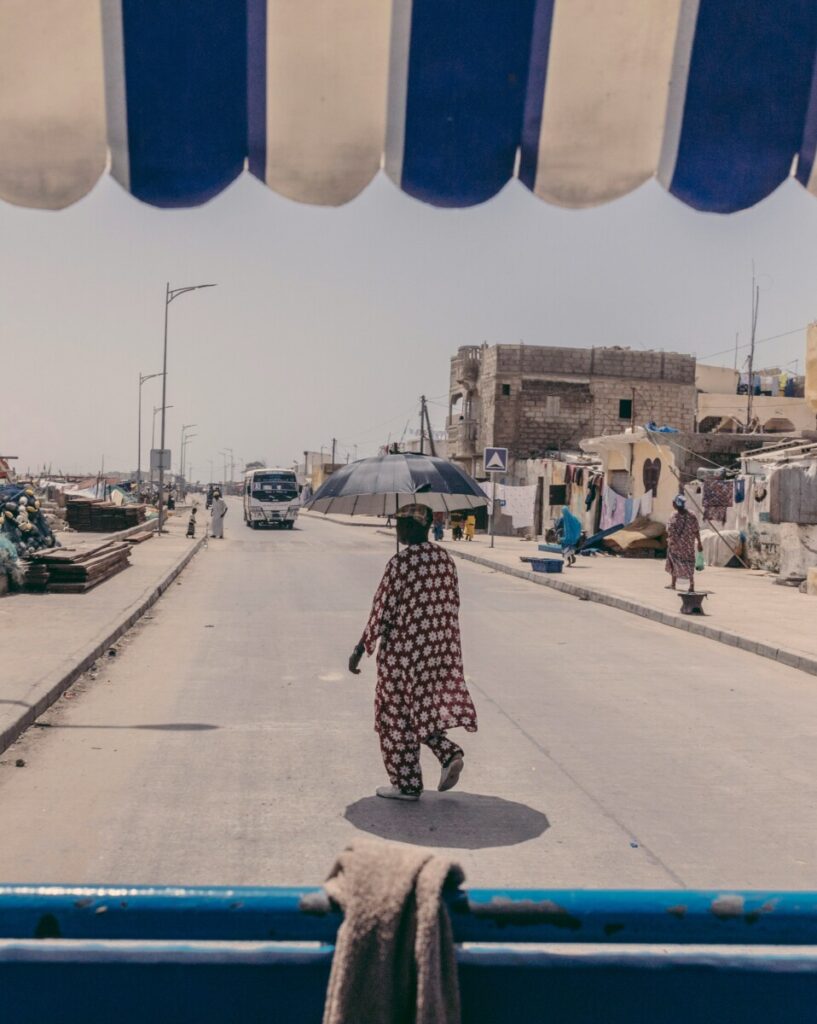We already shared some must-sees when visiting Senegal if you choose it as your destination to live your volunteer experience, and as great food lovers, we can’t hold back from recommending some dishes you must try if you travel to this destination.
Senegalese cuisine is very diverse and is deeply influenced by the country’s culture, climate, and history. Being a coastal country, some of its basic ingredients are fish, typically accompanied by rice, millet, peanuts, vegetables, and many tropical fruits.
Here are some typical dishes you’ll find in its streets and restaurants:

- THIEBOUDIENNE (CEEBU JËN)
This is one of the most iconic dishes of Senegal and is considered the national dish of the country. It is a very flavorful meal, traditionally prepared in one pot, consisting of fish, rice, and vegetables. This dish reflects Senegal’s rich culinary heritage, combining local ingredients with influences from other cultures.
Fresh fish is typically used, marinated in herbs and spices, such as yassa (a mix of garlic, onion, and mustard), and it is generally accompanied by white rice, although sometimes a variant, red rice, is used. The vegetables are also varied and may include carrots, cabbage, eggplant, cassava, and yuca. Lastly, a tomato sauce gives it its characteristic reddish color and a deep, delicious flavor, along with spices like parsley, garlic, onion, peppers, and sometimes chilies for a spicy touch.
The fish is marinated and then fried or steamed before being stewed with vegetables and tomato sauce. Everything is cooked together with the rice so that it absorbs the flavors from the fish broth and spices, resulting in a very aromatic and complete dish.
It is the star dish as it tells the story of Senegal, combining marine and agricultural ingredients and local culinary techniques.
- YASSA
Another very popular traditional dish in Senegal and in other parts of West Africa, like Guinea and Mali. It is known for its intense flavor and its sauce made from onion, lemon, and mustard. While the most famous version is chicken yassa (yassa poulet), it can also be prepared with fish or beef.
The main ingredients are the chosen protein, marinated for hours in a mixture of lemon juice, onion, garlic, and mustard. Abundant onion is used, giving the dish a characteristic texture and flavor. The lemon juice adds a refreshing acidity, while the mustard adds a mild spiciness. Garlic and peppers enhance the dish’s flavor, and olives may sometimes be added for a special touch.
As with most dishes, rice is used as a side, which creates a delicious flavor when mixed with the sauce.
After marinating the chicken, beef, or fish, they are browned and set aside. The onions are also marinated and cooked slowly until caramelized and soft.
The dish simmers with water or broth, allowing all the flavors to combine perfectly. It is finally served with white rice, resulting in a very tasty dish with a variety of flavors. It’s a simple dish but highly appreciated.
- MAFÉ
This dish is not only emblematic in Senegal but also in the cuisine of other countries like Mali, Gambia, and Guinea. It is also known as ‘peanut sauce,’ as it is a thick stew made from cream or peanut paste that gives it a rich, creamy flavor. Traditionally, it is prepared with meat, although it can also be made with chicken, fish, or even vegetarian.
It consists of the chosen protein (beef, lamb, chicken, or fish), peanut paste, and a variety of vegetables such as sweet potato, carrots, pumpkin, cabbage, and yuca. It is also made with a tomato sauce or paste, which adds acidity and color to the stew. Spices such as ginger, garlic, onion, peppers, and sometimes chili for a spicy touch are used. And of course, it is accompanied by rice or couscous.
The pieces of meat are browned in a large pot with a little oil to seal them and give them flavor. Onions, garlic, and spices are added to sauté with the meat. Then, peanut paste is mixed with water or broth and added to the pot, along with the tomato paste, to create the thick sauce, simmering while adding the vegetables to soften and absorb the stew’s flavor. Everything is cooked until the meat is tender and the vegetables are well cooked.
Mafé is served hot and is a comforting and nutritious dish, with a perfect combination of sweet, savory, and slightly spicy flavors. The peanut gives it a unique richness that makes it popular throughout the region.
- THIAKRY
Also known as “déguê” in some regions, it is a traditional dessert, a sweet and creamy dish made from couscous or millet grains mixed with dairy products, which can be served cold, making it refreshing and perfect for warm climates.
In the traditional version, millet is used, but couscous is common in more modern versions. Yogurt or buttermilk is added to give it a creamy and refreshing texture. In some versions, condensed milk or cream is also used. Sugar is added for sweetness, although the amount can vary to taste, along with essences like vanilla, orange blossom water, or rose water for flavoring the dessert. Sometimes raisins, nuts, or other dried fruits are added for additional texture and flavor.
The couscous or millet is cooked according to the instructions, generally steamed or boiled, and allowed to cool. Once cool, the couscous or millet is mixed with natural yogurt or buttermilk, sweetened to taste, and flavored before chilling to serve.
This dessert is very popular on special occasions and celebrations, but it is also consumed daily due to its simplicity and freshness.

- NDAMBÉ
Ndambé is a typical dish especially popular in the Casamance region. It is a stew made with fish, seafood, or meat, cooked with a blend of spices and usually served with rice or yuca.
Different types of fish (like grouper) or meat (chicken or beef) can be used. Various vegetables are added, including tomatoes, onions, peppers, and sometimes mustard greens or spinach. All this is seasoned with garlic, ginger, black pepper, and a blend of local spices. Palm oil is used to cook it, giving it a characteristic flavor, and this dish is also served with rice or fufu, which is a yuca puree.
The fish or meat is marinated with spices and left to rest to absorb the flavors. The oil is heated, and onions, garlic, and ginger are sautéed. Then tomatoes and vegetables are added, cooking them until tender. The fish or meat is incorporated and cooked until fully done.
Ndambé can vary depending on the region and the available ingredients, but the essence of the dish remains constant.
- BASSÍ SALTE
Another traditional dish from Senegalese cuisine that is also popular in the Casamance region. This dish consists of a kind of stew that includes several ingredients and is known for its robust and spicy flavor.
Beef or lamb is often used, although it can also be made with chicken. As for vegetables, it includes onion, peppers, tomatoes, and sometimes carrots or eggplants. It is commonly seasoned with garlic, ginger, paprika, and other local spices. It is also cooked with vegetable oil or palm oil, accompanying the final dish with rice or traditional bread, boul.
The meat is mixed with garlic, ginger, paprika, salt, and lemon juice and marinated for at least 30 minutes (or several hours if possible) to intensify the flavor. Palm oil is heated in a large pot, and onions are added, sautéing them until golden and fragrant. Next, tomatoes are added until they break down and form the sauce. The meat is then added and sautéed until browned, along with carrots and eggplants.
Finally, meat broth or water is added to cover the ingredients, bringing them to a boil, then reducing to a simmer for 30-40 minutes, and served hot.
Variations can be prepared with fish or seafood, as well as vegetarian versions using vegetables and legumes.
This dish represents the warmth and hospitality of Senegalese culture.
- LAKH
Also known as lakh de mil, it is popular for its simplicity and rich flavors. It is a stew based on rice accompanied by a variety of ingredients, including legumes and vegetables.
Generally, long-grain rice is used, and the vegetables include onion, tomatoes, carrot, peppers, spinach, or mustard greens, along with legumes such as chickpeas, beans, or lentils, and sometimes chicken, beef, or fish. All of this is seasoned with garlic, ginger, paprika, salt, and black pepper. It is also cooked with palm oil.
The rice is washed and cooked in salted water, either steamed or boiled. Meanwhile, in a pot with hot oil, the onion is sautéed until golden, and chopped tomatoes, peppers, and carrots are added until tender. The dried legumes are cooked separately and added to the stew, along with the chicken or meat until browned.
Once the vegetables and proteins are ready, the cooked rice is mixed with the stew, ensuring all ingredients are combined. It is served with a spicy chili sauce on the side, along with salad, yuca, or plantain.
This dish can be made completely vegetarian using only vegetables and legumes.
- THÉ (ATAYA)
It is a traditional tea drink that is very popular and a social ritual that fosters togetherness and hospitality.
It generally uses strong green tea, usually imported from China, and is flavored with mint, sugar, and, of course, water.
It’s simple but not just considered a drink; it’s also a moment to be with family, friends, or to welcome visitors. It can be a sign of status and generosity.

We can find more typical dishes such as Soupou Kandja, fattava, Capitaine à la Saint-Louisenne, and several others. All of them enhance the typical ingredients of the country and offer a unique and different experience to visitors.
Traveling is also about enjoying the local cuisine.




